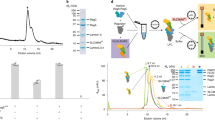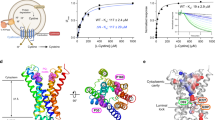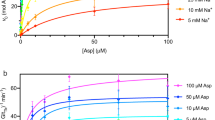Abstract
Recent advances in understanding intracellular amino acid transport and mechanistic target of rapamycin complex 1 (mTORC1) signaling shed light on solute carrier 38, family A member 9 (SLC38A9), a lysosomal transporter responsible for the binding and translocation of several essential amino acids. Here we present the first crystal structure of SLC38A9 from Danio rerio in complex with arginine. As captured in the cytosol-open state, the bound arginine was locked in a transitional state stabilized by transmembrane helix 1 (TM1) of drSLC38A9, which was anchored at the groove between TM5 and TM7. These anchoring interactions were mediated by the highly conserved WNTMM motif in TM1, and mutations in this motif abolished arginine transport by drSLC38A9. The underlying mechanism of substrate binding is critical for sensitizing the mTORC1 signaling pathway to amino acids and for maintenance of lysosomal amino acid homeostasis. This study offers a first glimpse into a prototypical model for SLC38 transporters.
This is a preview of subscription content, access via your institution
Access options
Access Nature and 54 other Nature Portfolio journals
Get Nature+, our best-value online-access subscription
$29.99 / 30 days
cancel any time
Subscribe to this journal
Receive 12 print issues and online access
$189.00 per year
only $15.75 per issue
Buy this article
- Purchase on Springer Link
- Instant access to full article PDF
Prices may be subject to local taxes which are calculated during checkout




Similar content being viewed by others
References
Rebsamen, M. et al. SLC38A9 is a component of the lysosomal amino acid sensing machinery that controls mTORC1. Nature 519, 477–481 (2015).
Wang, S. et al. Lysosomal amino acid transporter SLC38A9 signals arginine sufficiency to mTORC1. Science 347, 188–194 (2015).
Jack, D. L., Paulsen, I. T. & Saier, M. H. The amino acid/polyamine/organocation (APC) superfamily of transporters specific for amino acids, polyamines and organocations. Microbiology 146, 1797–1814 (2000).
Chang, H. C. & Bush, D. R. Topology of NAT2, a prototypical example of a new family of amino acid transporters. J. Biol. Chem. 272, 30552–30557 (1997).
Saier, M. H. Jr et al. The Transporter Classification Database (TCDB): recent advances. Nucleic Acids Res. 44(D1), D372–D379 (2016).
Västermark, Å. & Saier, M. H. Jr. Evolutionary relationship between 5 + 5 and 7 + 7 inverted repeat folds within the amino acid–polyamine–organocation superfamily. Proteins 82, 336–346 (2014).
Shaffer, P. L., Goehring, A., Shankaranarayanan, A. & Gouaux, E. Structure and mechanism of a Na+-independent amino acid transporter. Science 325, 1010–1014 (2009).
Wang, H. et al. Cloning and functional expression of ATA1, a subtype of amino acid transporter A, from human placenta. Biochem. Biophys. Res. Commun. 273, 1175–1179 (2000).
Varoqui, H., Zhu, H., Yao, D., Ming, H. & Erickson, J. D. Cloning and functional identification of a neuronal glutamine transporter. J. Biol. Chem. 275, 4049–4054 (2000).
Bröer, S. The SLC38 family of sodium–amino acid co-transporters. Pflugers Arch. 466, 155–172 (2014).
Christensen, H. N. Role of amino acid transport and countertransport in nutrition and metabolism. Physiol. Rev. 70, 43–77 (1990).
Schiöth, H. B., Roshanbin, S., Hägglund, M. G. A. & Fredriksson, R. Evolutionary origin of amino acid transporter families SLC32, SLC36 and SLC38 and physiological, pathological and therapeutic aspects. Mol. Aspects Med. 34, 571–585 (2013).
Gao, X. et al. Mechanism of substrate recognition and transport by an amino acid antiporter. Nature 463, 828–832 (2010).
Krishnamurthy, H. & Gouaux, E. X-ray structures of LeuT in substrate-free outward-open and apo inward-open states. Nature 481, 469–474 (2012).
Ressl, S., Terwisscha van Scheltinga, A. C., Vonrhein, C., Ott, V. & Ziegler, C. Molecular basis of transport and regulation in the Na+/betaine symporter BetP. Nature 458, 47–52 (2009).
Schulze, S., Köster, S., Geldmacher, U., Terwisscha van Scheltinga, A. C. & Kühlbrandt, W. Structural basis of Na+-independent and cooperative substrate/product antiport in CaiT. Nature 467, 233–236 (2010).
Malinauskaite, L. et al. A mechanism for intracellular release of Na+ by neurotransmitter/sodium symporters. Nat. Struct. Mol. Biol. 21, 1006–1012 (2014).
Wyant, G. A. et al. mTORC1 activator SLC38A9 is required to efflux essential amino acids from lysosomes and use protein as a nutrient. Cell 171, 642–654 (2017).
Watanabe, A. et al. The mechanism of sodium and substrate release from the binding pocket of vSGLT. Nature 468, 988–991 (2010).
Faham, S. et al. The crystal structure of a sodium galactose transporter reveals mechanistic insights into Na+/sugar symport. Science 321, 810–814 (2008).
Zhang, Z., Gameiro, A. & Grewer, C. Highly conserved asparagine 82 controls the interaction of Na+ with the sodium-coupled neutral amino acid transporter SNAT2. J. Biol. Chem. 283, 12284–12292 (2008).
Zhang, Z., Albers, T., Fiumera, H. L., Gameiro, A. & Grewer, C. A conserved Na+ binding site of the sodium-coupled neutral amino acid transporter 2 (SNAT2). J. Biol. Chem. 284, 25314–25323 (2009).
Bröer, S., Schneider, H. P., Bröer, A. & Deitmer, J. W. Mutation of asparagine 76 in the center of glutamine transporter SNAT3 modulates substrate-induced conductances and Na+ binding. J. Biol. Chem. 284, 25823–25831 (2009).
Castellano, B. M. et al. Lysosomal cholesterol activates mTORC1 via an SLC38A9–Niemann-Pick C1 signaling complex. Science 1311, 1306–1311 (2017).
Efeyan, A., Zoncu, R. & Sabatini, D. M. Amino acids and mTORC1: from lysosomes to disease. Trends Mol. Med. 18, 524–533 (2012).
Platt, F. M. Emptying the stores: lysosomal diseases and therapeutic strategies. Nat. Rev. Drug Discov. 17, 133–150 (2018).
Lim, H. H., Fang, Y. & Williams, C. High-efficiency screening of monoclonal antibodies for membrane protein crystallography. PLoS One 6, e24653 (2011).
Fokin, A. V. et al. Spatial structure of a Fab-fragment of a monoclonal antibody to human interleukin-2 in two crystalline forms at a resolution of 2.2 and 2.9 angstroms. Bioorg. Khim. 26, 571–578 (2000).
Adams, P. D. et al. PHENIX: a comprehensive Python-based system for macromolecular structure solution. Acta Crystallogr. D Biol. Crystallogr. 66, 213–221 (2010).
Emsley, P., Lohkamp, B., Scott, W. G. & Cowtan, K. Features and development of Coot. Acta Crystallogr. D Biol. Crystallogr. 66, 486–501 (2010).
Biasini, M. et al. SWISS-MODEL: modelling protein tertiary and quaternary structure using evolutionary information. Nucleic Acids Res. 42, W252–W258 (2014).
Schrödinger, L. The PyMOL Molecular Graphics System, Version 2.0 (Schrödinger, LLC, 2015).
Sievers, F. et al. Fast, scalable generation of high-quality protein multiple sequence alignments using Clustal Omega. Mol. Syst. Biol. 7, 539 (2011).
Robert, X. & Gouet, P. Deciphering key features in protein structures with the new ENDscript server. Nucleic Acids Res. 42, W320–W324 (2014).
Acknowledgements
We thank D. Cawley for development and production of monoclonal antibodies. We thank K. Rajashankar and the staff at NECAT for their support with X-ray data collection. We thank D. Casio and J. Hattne for discussions over X-ray data collection and structural determination. We thank L. Shao and S. Liu for critical reading of the manuscript. This work is based upon research conducted at the Northeastern Collaborative Access Team beamlines, which are funded by the National Institute of General Medical Sciences from the US National Institutes of Health (P41 GM103403). The Pilatus 6 M detector on the 24-ID-C beamline is funded by an NIH-ORIP HEI grant (S10 RR029205). This research used resources of the Advanced Photon Source, a US Department of Energy (DOE) Office of Science User Facility operated for the DOE Office of Science by Argonne National Laboratory under contract DE-AC02-06CH11357. Research in the Gonen laboratory is funded by the Howard Hughes Medical Institute.
Author information
Authors and Affiliations
Contributions
H.-T.L., J.M. and T.G. designed the project. H.-T.L. and J.M. performed experiments, including protein preparation, antibody screening, crystallization and data collection. H.-T.L. performed model building and refinement. S.S.M. and H.-T.L. performed the radioligand uptake assay. H.-T.L., J.M. and T.G. participated in data analysis and figure preparation. H.-T.L., J.M. and T.G. wrote the manuscript.
Corresponding author
Ethics declarations
Competing interests
The authors declare no competing interests.
Additional information
Publisher’s note: Springer Nature remains neutral with regard to jurisdictional claims in published maps and institutional affiliations.
Integrated Supplementary Information
Supplementary Figure 1 Overall structure of drSLC38A9.
a, Central panel, side view in plane of lysosomal membrane. The position of the Fab fragment bound on the luminal side is shown by a gray triangle above the luminal loops. Left panel, cytosolic view showing the vestibule at the cytosolic side. Right panel, luminal view. At the luminal side, residues on TM1b, loop 5–6 and loop 7–8 are grouped in cluster 1 (W128, K131, Q132, R344, E411, P415) and those in TM6a, TM10 and TM11 are grouped in cluster 2 (P348, G491, R495, N542, Q546). An enlarged window from the luminal view encompasses luminal gating cluster 1 and cluster 2. b, The electron density of the determined asymmetric unit of drSLC38A9–Fab crystals. Each asymmetric unit contained two drSLC38A9 molecules (labeled SLC38A9 mol 1 and mol 2) as well as two Fab fragments (labeled Fab mol 1 and Fab mol 2). c,d, Examples of the quality of the electron density maps in the determined structure with fitting of the model of drSLC38A9–Fab.
Supplementary Figure 2 Crystal packing and asymmetric unit of the drSLC38A9–Fab complex.
a, Crystal packing showing the drSLC38A9–Fab complex lattice. Fab fragments (gray) stack tightly along the crystallographic b axis and are connected by drSLC38A9 (cyan) layers in the crystallographic ac plane in a propeller-like head-to-side manner. One asymmetric unit is selected to show the building block that is composed of two Fab (orange) and two drSLC38A9 (red) molecules. b, Interactions between drSLC38A9 and adjacent Fab fragments. One drSLC38A9 (red) makes contacts with four other molecules. The biologically functional contact is between the luminal loops of drSLC38A9 (red) and the complementarity-determining regions (CDRs) of the Fab (orange). The three other contacts, which appear to be crystal contacts and nonspecific, occur between loop 2–3 (red) and TM5 (blue 1) and between TM3, TM10 (red) and a groove shaped from the two adjacent Fab fragments (green 2 and yellow 3).
Supplementary Figure 3 Superposition of drSLC38A9 (colored) and AdiC (3L1L) (translucent yellow).
TM3, TM4, TM8 and TM9 are used in the superimposition. The location of the bound arginine in drSLC38A9 is shown by the dashed oval. Structural alignment was performed in PyMOL. AdiC to drSLC38A9; r.m.s. deviation = 3.57 Å, Cealign for 72 residues.
Supplementary Figure 4 Elution profile of the ΔN-SLC38A9–Fab assembly.
a, The solid line represents the elution trace of the ΔN-SLC38A9–Fab complex and unbound Fab. The dashed line is the elution trace of pure ΔN-SLC38A9. An apparent peak shift was observed for the formation of the ΔN-SLC38A9–Fab complex. b, Fractions selected in the red box in a were sampled and analyzed by SDS–PAGE before being pooled and concentrated for crystallization.
Supplementary information
Supplementary Text and Figures
Supplementary Figures 1–4 and Supplementary Notes 1 and 2
Rights and permissions
About this article
Cite this article
Lei, HT., Ma, J., Sanchez Martinez, S. et al. Crystal structure of arginine-bound lysosomal transporter SLC38A9 in the cytosol-open state. Nat Struct Mol Biol 25, 522–527 (2018). https://doi.org/10.1038/s41594-018-0072-2
Received:
Accepted:
Published:
Issue Date:
DOI: https://doi.org/10.1038/s41594-018-0072-2
This article is cited by
-
Lipid flipping in the omega-3 fatty-acid transporter
Nature Communications (2023)
-
The molecular basis of nutrient sensing and signalling by mTORC1 in metabolism regulation and disease
Nature Reviews Molecular Cell Biology (2023)
-
d-Tryptophan enhances the reproductive organ-specific expression of the amino acid transporter homolog Dr-SLC38A9 involved in the sexual induction of planarian Dugesia ryukyuensis
Zoological Letters (2021)
-
Progress in Structural Biology of Solute Carriers
Current Molecular Biology Reports (2021)
-
Structural mechanism for amino acid-dependent Rag GTPase nucleotide state switching by SLC38A9
Nature Structural & Molecular Biology (2020)



